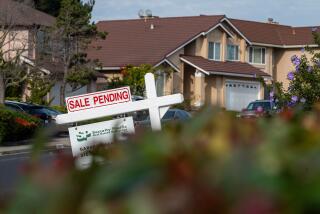After the Sale: Correcting Overlooked House Defects
- Share via
Question: For the first time since moving into my home, I went to switch on the patio light but could not find a switch. Now I find that there simply is no switch. Shouldn’t the home inspector have found this problem, and shouldn’t the sellers have disclosed this?
Answer: The sellers probably were aware of this deficiency and should have disclosed it, but it may have simply slipped their minds. In many cases, homeowners become so used to long-standing defects that they fail to think of them when asked to make a list of inherent problems. This may be one of those things. Nevertheless, they are liable for nondisclosure.
Likewise your home inspector should have discovered this defect. Most home inspectors check the majority of lights and switches, but not necessarily every single one.
In fact, many home inspection reports specify that random samplings of switches be tested. Notwithstanding this disclaimer, most reputable home inspectors would be willing to pay for this type of correction to enhance good client relations and promote a solid business reputation.
A positive approach would be to contact the sellers and the home inspector. A concerned inspector will gladly take a second look at this condition, and an ethical seller will recognize the need to make good on an undisclosed defect.
Getting Developersto Make Home Repairs
Q: When I purchased my home, it was brand-new, but my home inspector still found some defects. The developers promptly repaired these as a condition of the sale.
Since then, more problems have turned up, but the developers are no longer interested. I’ve complained numerous times, but they won’t return my calls. I’ve even notified the appropriate state agencies, but all they offer is red tape and further delays.
How does one deal with this kind of situation?
A: Builders are required to guarantee their work for one or more years, depending upon the specific laws in the state where the construction occurs. Unfortunately, not all property developers take these obligations seriously.
Regulatory agencies are empowered to enforce these requirements, but often they are inefficient and even negligent in the enforcement of consumer protection laws.
For action against a builder, you may have to employ an attorney. But before opening that Pandora’s box of protracted aggravation, you might try this:
Send a certified letter, giving the developers 30 days to correct a list of specific problems. Inform them that if they fail to perform in a timely and forthright manner, you will hire your own contractors to execute the repairs and will hold them responsible for the costs of that work.
If you document this well, a Small Claims Court judge is likely to rule in your favor. But be sure to obtain legal advice before proceeding.
Cleaning Forced-Air Heating Ducts
Q: Allow me to take exception to your earlier article advising the cleaning of forced-air heating ducts. I don’t believe there is much evidence to support the benefits of duct cleaning. While it probably won’t hurt, it bears pointing out that the U.S. Environmental Protection Agency does not recommend duct cleaning and has no evidence that it improves human health.
A:If you could view the interior surfaces of certain forced-air heating ducts, as seen by home inspectors and HVAC contractors, you would be appalled at the prospect of inhaling air that is discharged from those outlets. This is certainly not the case with all forced-air systems, but in many homes, occupants are unknowingly breathing air that has been circulated over layers of visible filth.
In older homes, many forced-air heaters have been operated for years with dirty filters or with no filters at all. The accumulated dust on the inner duct surfaces is often oily or moist and may contain mites or various species of molds or fungus.
In newer homes, where air-tight construction methods are employed for enhanced energy conservation, the growth of mold spores has become recognized as a significant indoor air quality hazard. In these cases, air ducts provide a common harbor and distribution mechanism for biological air contaminants.
To discount these realities, simply because a governmental agency has failed to recognize them, is to accord a higher level of trust and dependence upon bureaucratic institutions than such entities fairly warrant.
Sooner or later, the EPA is likely to acknowledge the potential health hazards associated with dirty warm-air ducts. But the problem will continue to exist, with or without that recognition.
*
If you have questions or comments, contact Barry Stone through his Web site at https://www.housedetective.com. Distributed by Access Media Group.
More to Read
Inside the business of entertainment
The Wide Shot brings you news, analysis and insights on everything from streaming wars to production — and what it all means for the future.
You may occasionally receive promotional content from the Los Angeles Times.










